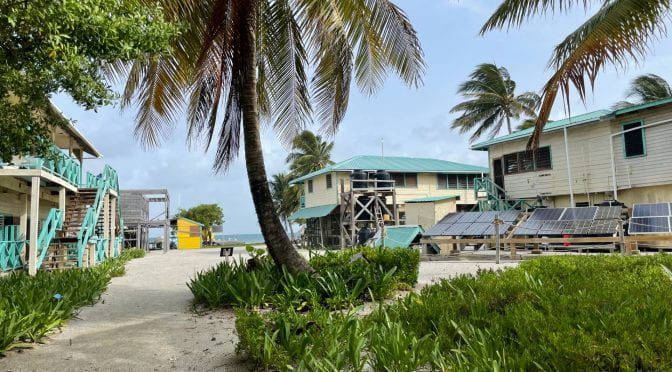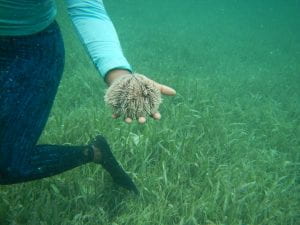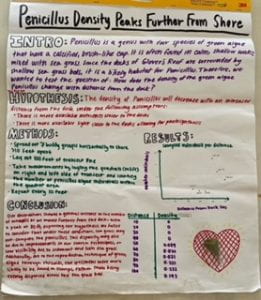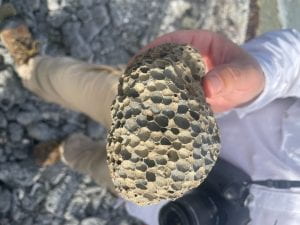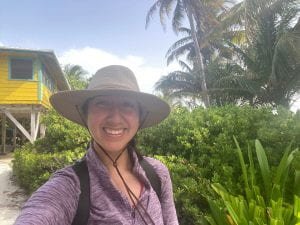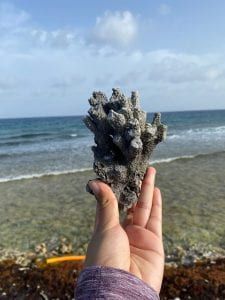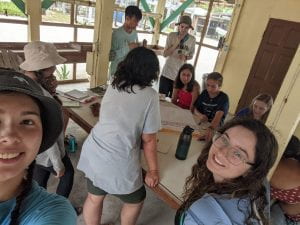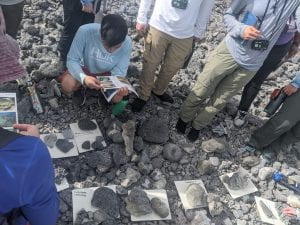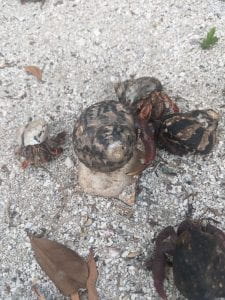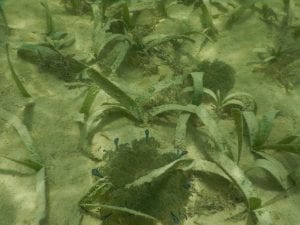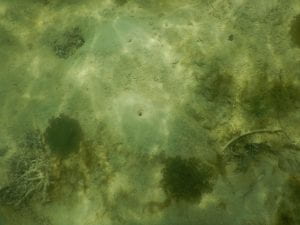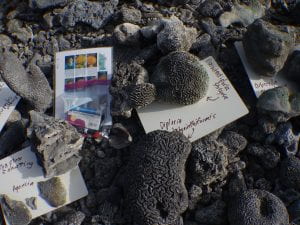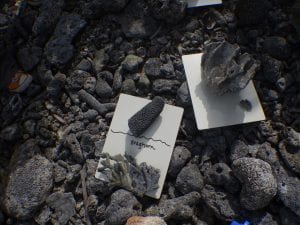We hopped straight into the seagrass, and with fuzzy moss tickling our shins, we began to dance the stingray shuffle, dragging our feet from side to side (just like the Dune worm dance) to warn the stingrays we were coming. This morning, we searched the seabed for critters to observe and analyze in the wet lab. Recruiting all catch-worthy objects, we went in equipped with little fish nets, metal tongs, paper trays, and paint buckets. This was a team effort; half of the class stood in a circle to enclose a fish as one of us tried to scoop it up with a paper tray.
Some of us went off to cover more ground. I shuffled further out in the grasses, and my water shoe bumped into a rock-shaped mass in the sand. I reached my arm in and pulled out a conch shell with a fish inside, but I accidentally poured out the fish while examining my catch. The feel-around and reach-in technique became my strategy, and my next finds included a bright orange sea snail, decaying logs, and a pipe used by the island. Our class also gathered a box jellyfish (it looked just like a wubble bubble), chilling in the shallow water near the mangroves; a decorator crab; a cute little shrimp; and several anchovy-looking fish that sadly died on us immediately due to a lack of oxygen. Adam, our cryptobenthic fish expert, explained to us that these tiny, floor-dwelling fish are so fragile because of their living strategy – reproduce more and live less.
We spent the next half of our day exploring the coral cemetery – a stretch of shoreline filled with mounds of fossilized coral. Just like the limestone caves and soils of the rainforest, both the island and the surrounding coral reefs were built from the foundational element calcium. Though the fossilized coral had lost their vibrant colors, we identified 7 species from their distinct shapes, including elkhorn, brain, lettuce, finger, montastraea, and fan coral.
(Coral Cemetery – 05/29/25)
As we made our way down the piles of calcium and closer to the shore, we saw the succession of life. Living species were growing in the low tide zone, fresh coral remains lay midway up the slope, and fossils sat at the top. I also saw a few washed-up chunks of sponge, which had the harsh, bristly texture and pale pink color and texture of an azure vase sponge. Lifting rocks sitting in the shallow water, we uncovered a spiny black sea star along with sea urchins scattered across the ground—like the little black fuzzballs from My Neighbor Totoro.
(Sea Urchin Spotting – 05/27/25)
Our next stop along the trail around the island was a sand bank right outside the island, otherwise known as a mound of parrotfish poop. We looked into the peaceful horizon, listening to the crash of the waves, and stared out into the horizon. I saw a leaf-shaped object drifting nearby and scooped it up to discover that it was a tiny, lifeless baby pufferfish. The view out was gorgeous, but turning back towards our island, microplastics lined the shore left and right. We’re planning a trash pickup soon to do our part and protect this beautiful place.
(Gorgeous Waters – 05/27/25)
(Microplastics – 05/27/25)
Peace,
Lily H. 🙂 2025





